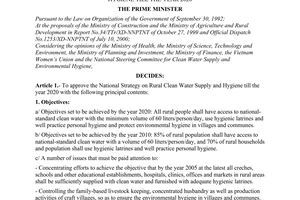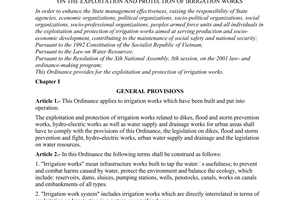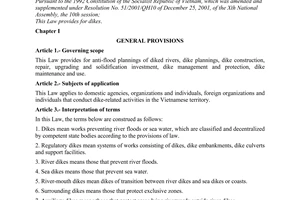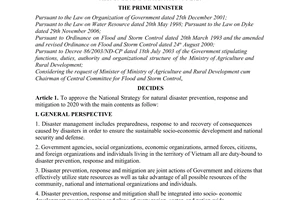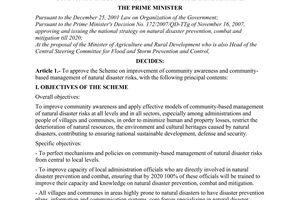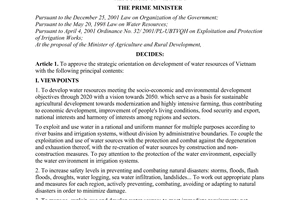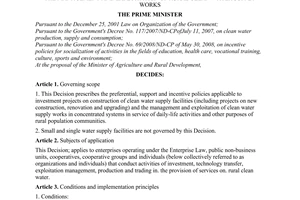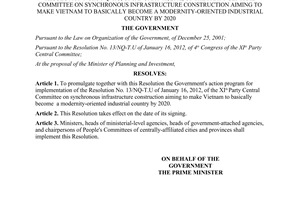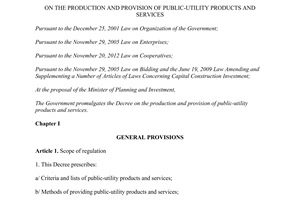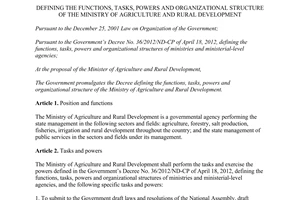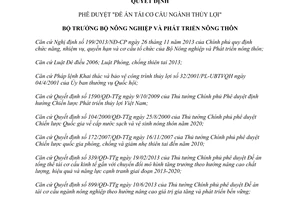Nội dung toàn văn Decision No. 794/QD-BNN-TCTL dated 2014 approving Scheme of restructuring of irrigation sector
|
MINISTRY
OF AGRICULTURE AND RURAL DEVELOPMENT |
SOCIALIST
REPUBLIC OF VIETNAM |
|
No.: 794/QD-BNN-TCTL |
Hanoi, April 21, 2014 |
DECISION
APPROVING “SCHEME OF RESTRUCTURING OF IRRIGATION SECTOR”
MINISTER OF AGRICULTURE AND RURAL DEVELOPMENT
Pursuant to Decree No. 199/2013/ND-CP dated November 26, 2013 of the Government defining the functions, tasks, powers and organizational structure of the Ministry of Agriculture and Rural Development;
Pursuant to the Law on Dikes 2006 and the Law on Natural Disaster Prevention and Control 2013;
Pursuant to the Ordinance on exploitation and protection of irrigational works No. dated April 04, 2001 of the National Assembly Standing Committee;
Pursuant to the Decision No. 1590/QD-TTg dated October 9, 2009 of Prime Minister approving the orientation of Vietnam irrigation development Strategy;
Pursuant to the Decision No.104/2000/QĐ-TTg dated August 25, 2000 of the Prime Minister approving the National Strategy on clean water supply and rural sanitation by 2020;
Pursuant to Decision No. 172/2007/QD-TTg dated November 16, 2007 of the Prime Minister approving the National Strategy for prevention and mitigation of natural disasters by 2010;
Pursuant to the Decision No. 339/QD-TTg dated February 19, 2013 of the Prime Minister approving the overall scheme of economic restructuring associated with the growth pattern towards improving quality, efficiency and competitiveness 2013-2020 period;
Pursuant to the Decision No. 899/QD-TTg dated June 10, 2013 of the Prime Minister approving the scheme of restructuring of agricultural sector towards improving the added value and sustainable development;
At the proposal of the Director of the Directorate of Water Resources
DECIDES:
Article 1. Approving the Scheme “Restructuring of irrigation sector” with the following main contents:
I. OBJECTIVES AND VIEWPOINT.
1. Objective.
Improving efficiency of irrigation sector for restructuring of agricultural sector towards improving the added value and sustainable development; meeting the development requirements of social and economic sectors; improving the capacity for natural disaster prevention and response to climate change (CC); contributing to the modernization of agricultural and rural infrastructure and new rural construction.
2. Duties
a) Consolidating and developing interior field irrigation, associated with the new rural construction: Upgrading the interior field irrigation infrastructure to meet the good farming practices to improve productivity, product quality, reduce production costs, meet market requirements with flexibility, improve farmers' income; strengthen the sustainable grassroots agricultural hydraulic organizations (cooperative, cooperative groups);
b) Strengthening organizations that manage the exploitation of irrigational works: Improvement of management efficiency, innovation of operation mechanism, improvement of quality of services systems and quality of works systems, prevention of degradation, technical and financial sustainability and gradual modernization;
c) Developing a proactively irrigated agriculture towards modernization: Widely promoting advanced and water-saving solutions to irrigation for the key upland crops: coffee, pepper, tea, cashew, sugarcane, fruit, vegetables, flowers…mainly in Central Highlands, Southeast, Central Coast and northern mountains.
d) Developing the irrigation infrastructure in service of the intensive aquaculture area with the key species (black tiger shrimp, white shrimp, catfish, tilapia) in the Mekong River delta and the Central coastal region.
e) Improving the level of safety assurance for natural disasters, storms, floods, safety of lakes and dams. Proactive prevention, avoidance or adaptation to minimize losses and safely protect the residents, ensure the stability and and production development in terms of climate change and sea level rise.
f) Improving the effectiveness of risk management of natural disaster and dam safety by application of advanced technologies and improving capacity of disaster forecasting and warning, giving the priority to the nonstructural solutions.
g) Improving the effectiveness of management of exploitation of rural domestic water supply towards the sustainability in terms of infrastructure, models and financial management.
3. Viewpoint
a) Restructuring the irrigation sector is both the content and solution to carry out the restructuring of agricultural sector towards the improvement of value-added and sustainable development
b) Implementing strong decentralization of investment, management and exploitation of irrigational works; gradually converting the mechanism of operational management of irrigational works towards market orientation.
c) Strongly transferring the subjects served by irrigation from pure agricultural production (rice as a primary plant) to multi-purpose service, giving high priority to aquaculture, development of industrial crops, fruit trees, medicinal herbs, ..., for industrial production and people's life.
d) Improving the effectiveness of natural disaster prevention and control, applying advanced technology combined with the capacity of prevention and control of community, promoting non-structural measures. Actively responding to climate change, enhancing the management of natural resources and environmental protection.
e) Developing internal strength and enhancing the subjective role of people on the basis of promoting socialization, mobilizing the participation of all economic sectors in the investment, construction and management of exploitation of irrigational works .
II. ORIENTATION
1. Improving the effectiveness of management and exploitation of irrigational works system
1.1. With the system of interior field irrigation
a) Upgrading the system of interior field infrastructure to improve productivity, quality and effectiveness of agricultural production to meet the requirements of agricultural restructuring, associated with the new rural construction.
- With an area of rice cultivation: Upgrading and renovating the irrigation infrastructure, associated with the construction of interior filed roads, land consolidation and leveling of field to be able to apply advanced farming methods; reorganizing the production with large scale, promoting mechanization, contributing to improve productivity, reduce costs of fertilizer, pesticide, water conservation, reduce greenhouse gas emissions and improve people’s income.
- With a land area of restructuring of crops, livestock or combined farming: required upgrading of interior field irrigation infrastructure to apply appropriate advanced farming methods.
b) Strengthening the grassroots irrigation management organization
- Reviewing, consolidating and organizing cooperatives and establishment on a basis of voluntariness, cooperation, equality, co-ownership and mutual assistance between cooperative members to provide benefits for members; at the same time, organizing the grassroots irrigation management associated with the new rural construction.
- Based on the characteristics of the regions in terms of natural, economic, and social conditions and scale of irrigational works systems to propose different organizational models: multi-service cooperatives, cooperative only performing water services, cooperative groups,.... developing a uniform policy system to support and strengthen organizations, management capacity and ability to participate in providing various services to sustainably develop the grassroots irrigation.
1.2. With the system of companies and factories managing the exploitation of irrigational works
- Continuing to complete the system: upgrading canal and ditch system or works on canals, newly building the canal and ditch system and pumping stations to increase the percentage of area supplied with water, capacity of water drainage system; giving priority to the irrigational works system in the Central region, the Central Highlands, the Mekong Delta.
- Developing items of works to enhance the capacity to provide services with fee collection such as: water supply for domestic and industrial utilization, services and other forms of agricultural production of high added value; increase revenues, reduce subsidies from the state budget, enhance motivation to improve the effectiveness of exploitation management of irrigational works.
- Prioritizing the investment in equipment and technology to enhance capacity of forecasting of drought, saltwater intrusion, flooding, ... in the system, improve the capacity of management of system operation;
- Improving the effectiveness of management of irrigation systems: fundamental transformation of operational mechanism of exploitation management from the mechanism for assignment of plan to the mechanism for order or bidding of exploitation management; encouragement of expansion of activities to provide clean water for domestic, industrial utilization, high-tech agriculture; application of advanced management processes to improve the productivity and effectiveness of business and production;
2. Developing the irrigation for upland crops
- Synchronously and widely applying the advanced and water-saving irrigation solutions to improve the productivity, quality, effectiveness and risk reduction for all major crops with high economic value such as coffee, pepper, cashew, sugarcane, tea, fruit trees and other upland crops; encouraging the fabrication technology to produce and provide services for water-saving and advanced irrigation;
- Continuing to build the irrigational works system (reservoirs of small and medium scale, pumping stations, water transfer system with pressure and channels) to create the irrigation water for concentrated industrial crops, giving the priority to the Highlands, Central and Southeast region; simultaneously, supplying water for the slope areas to increase the cultivated area, crops, effectively and sustainably exploiting the slope area, contributing to poverty alleviation, reduction of deforestation for the Northern mountainous and Central region.
3. Developing irrigational works infrastructure for aquaculture
- Central coast region: Continuing to build the reservoirs as planned, connecting the reservoirs to create water sources, building water irrigation system to supply water for industrial parks, services, supply water for agriculture and fisheries in coastal areas associated with reorganization of production and water-saving aquaculture and water treatment after raising; ensuring clean water sources (salty and fresh water) for aquaculture with the advanced process of technology, high productivity and safety.
- Mekong river delta: Applying the irrigational solutions for sustainable aquaculture. Investing in infrastructure to actively get water (salty and fresh water) in combination with the water-saving raising method with water treatment to ensure the water environment for concentrated or industrial raising area of aquaculture (catfish and brackish water fish and aquatic animals);
4. Improving the level of safety assurance of lakes and dams
- Strengthening the state management of dam safety (DS), ensuring strict management of DS from planning, survey, design, construction and operation management; continue reviewing and improving the system of regulations and standards of design in terms of climate change; access to international experiences.
- Enhancing the safety assurance for the downstream area of dam: strengthening inter-sectoral coordination for forecasting and warning of flood, operation of reservoir and flood prevention and control for the downstream area of dam;
- Improving capacity for rain and flood forecasting, reasonable reservoir operation, regulation of flood discharge from inter-reservoir towards real-time operation. Strengthen monitoring equipment; increased flood discharge capacity of large reservoirs according to international standards; improving flood discharge for small and medium reservoirs and continuing to strengthen and upgrade dams;
5. Improving capacity for natural disaster prevention
- Continuing the carry out the objectives and duties in the Strategy of prevention, control and mitigation of natural disaster; reviewing and adjusting the Strategy of prevention and control of natural disaster in accordance with the Law on Natural Disaster Prevention and Control and the requirements and duties newly set;
- Developing plan for risk management of natural disaster and the plan for general management of floods for river basins; developing plan and roadmap for implementation. Giving priority to the following key tasks:
+ Enhancing the institutional capacity for the Steering Committee for natural disaster prevention and control at all levels;
+ Formulating and reviewing the planning and plans for risk management of natural disaster; giving priority of setting flooding map and hazard map due to storms and sea level rise; developing the process of operation of reservoirs and works of flood and storm prevention and control;
+ Improving capacity for forecasting and warning of floods, enhancing the installation of information survey equipment of reservoirs, survey of floodplain, flood; coordinating with the Ministry of Natural Resources and Environment to complete the system of survey and hydro-meteorological forecasting; giving the priority to the river basins and reservoirs in the Central region;
+ Raising the awareness and risk management of natural disaster relying on the community, strengthening the implementation of motto "4 spots", boosting the implementation of project "Raising public awareness on the prevention and mitigation of natural disasters of people " under the Decision No.1002/QD-TTg dated July 13, 2009 of the Prime Minister;
+ Strengthening the system of flood warning information; reviewing the police on rescue and recovery after floods; continuing to implement the structural solutions, giving priority to the review of works obstructing flood drainage capacity downstream. Continuing to review the planning, enhancing flood storage capacity, giving space for water in river basins, reservoir system in urban and rural areas; continuing to study solutions to the prevention of large floods that can occur, giving priority to the watersheds of Red, Dong Nai - Sai Gon, Ma and Ca river ... Enhancing capacity to cope with large storms.
- Enhancing capacity for management of river and sea dike system, management of river bank and seashore landslide:
+ Continuing to improve capacity for research and forecasting of impacts of climate change, upstream development, impacts of downstream areas of watersheds (such as groundwater extraction, and land subsidence) to the irrigational works system, such as river and sea dikes, pumping stations, offtakes to propose solutions to adaptation and mitigation;
+ Enhancing capacity for management landslide for immediate handling upon its occurrence, handling landslide by the principle of regulation of river and sea. Promoting landslide handling by environmentally friendly solutions, planting breakwater trees and mangroves.
- Continuing to study and improve the flooding prevention planning for large cities and rural residential areas; implementing the solutions to flooding prevention for urban and rural areas;
IV. KEY SOLUTIONS
1. Improving the quality of irrigation planning, enhancing the implementation management under the planning
a) Đổi mới công tác quy hoạch. Innovation of planning
- Irrigation planning is closely associated with restructuring of agricultural sector; application of scientific and technological progress of irrigation and re-organization of agricultural production;
- Planning of irrigation development associated with the improvement of effectiveness of exploitation management of irrigational works system (IW), improvement of effectiveness of water supply services with fee collection, encouragement of public-private investment cooperation to create resources for irrigation development;
- Improving capacity for research and forecasting of impacts of climate change and adverse effects during the social-economic development on the basin rivers (both upstream and downstream) to propose solution “no regret”. Regarding the nonstructural solutions as significant solutions in the planning and formulation of plan for irrigational development;
b) Reviewing nationwide irrigational planning
- Evaluating and adjusting duties of irrigational works systems (IW) including: infrastructure, method of exploitation management, capacity of staff, current situation and ability to expand services supply. Renewing the basic survey method, using the assessment tool Rap / Masscote; performing the evaluation of irrigational works on a national scale as a basis for adjusting the duties of irrigational works system.
- Reviewing the irrigation planning in the country with the objective of restructuring of agricultural sector in terms of climate change with a number of key duties as follows:
+ Reviewing the irrigation planning for aquaculture : ( 1 ) Central Coast Area : reservoir building planning on the river basins to contribute to flood control and water storage in the dry season; associated reservoirs, utilization of water from water transfer of Dong Nai river basin through Dai Ninh hydropower , Hinh, Da Nhim , Kanak - An Khe , Ham Thuan - Da Mi river ... to provide water for watersheds . Encouraging the investment in the form of public-private cooperation to irrigate and provide water for industrial parks, tourism services, agriculture and aquaculture in coastal areas; reorganization of aquaculture production under industrial scale, water-saving farming and water treatment after the; ( 2 ) Mekong River Delta: Reviewing and adjusting irrigation planning towards the aquaculture, focusing on catfish and shrimp in brackish water .
+ Reviewing irrigation planning to provide water for upland crops with large-scale production: coffee trees in the Central Highlands, Southeast and Northwest; cashew trees in the South East, Central Highlands, South Central Coast; pepper in the Southeast, the Central Highlands and North Central Coast; tea trees in the Northern mountainous midlands, Central Highlands; rubber trees in some areas with favorable conditions of water sources; sugarcane in the Northern mountainous midlands and Central coast, Central Highlands, Southeast and Mekong river Delta; fruit trees in the Mekong river Delta and northern mountainous region.
c) Planning and plans for prevention and control of natural disaster and dam safety
- In prevention and control of natural disaster: Implementing the strategy of prevention, control and mitigation of natural disaster, developing national plans for prevention and control of natural disaster. Focusing on developing plans for general management of floods of river basins and for risk management of natural disaster for regions and localities; preparing roadmap of implementation and carrying out the monitoring, inspection and supervision through the set of assessment indicators;
- Flood planning: Innovating and improving the quality of flood planning, promoting research and forecasting the most unfavorable scenario due to the impact of climate change and operating upstream reservoirs to prevent downstream flood; evaluating the process of development of transportation, urbanization, impacts of downstream flood; including the contents of river regulation planning in the flood control planning or natural disaster prevention and control planning. Strengthening the management of downstream land relating to flood planning.
- Dam safety: Adjusting and supplementing the Program of reservoir safety, reviewing reservoirs and dams at risk of safety loss, inspecting dams and re-evaluating floods and levels to ensure the safety of reservoirs and dams; gradually raising the safety level based on international standards for large reservoirs; enhancing capacity for flood forecasting and gradually operating the real time for large reservoirs; strengthening solutions to ensure the safety for downstream areas upon flood discharge and in case of dam failure incident;
2. Improving policies and institution
a) Improving institution and legal normative documents:
- Formulating the Law on Irrigation; the Decrees guiding the Law on Natural Disaster Prevention and Control and Decree amending and superseding Decree No. 72/2007/ND-CP dated May 07, 2007 of the Government on safety management of dam. Reviewing and synchronizing the system of legal normative documents on irrigation, paying attention to the improvement of socialist-oriented market economy institution, raising the subjective role of people and the parties concerned in terms of irrigation;
- Continuing to innovate the system of companies managing the exploitation of irrigational works: completing documents guiding the implementation of Decree No. 130/2013/ND-CP dated November 29, 2013 of the Government on production and supply of products, public services…adjusting, reviewing and completing technical standards and regulations and the system of technical-economic norm; improving the legal grounds to promote and replicate the general exploitation activities, services with fee collection to increase revenues, enhance self-reliance, financial sustainability and motivation to attract the human resources; strengthening the management organization of irrigational works exploitation, from inter-provincial system to inter-district and commune systems; clarifying the responsibilities of state management, management of exploitation of irrigational works systems.
- Strengthening, innovating and sustainably developing the grassroots irrigation organization: continuing the improvement of legal document system to guide the operation of grassroots irrigation organizations (cooperatives, cooperative groups of water utilization), strengthening the training on management of operation and technology science for the grassroots irrigation organizations, issuing policies to support and strengthen organization and create motivation for sustainable development of grassroots irrigation organizations, developing the management mechanism of programs and projects (clean water, rural environmental sanitation, interior field irrigation…) associated with new rural construction;
- Improving the institution, enhancing the socialization and sustainably managing the rural clean water, including:
+ Continuing to improve the system of documents guiding the implementation of socialization of clean water sector; reviewing the system of relevant legal normative documents to implement on a large scale the participation of private sector in investment, construction, management and operation of rural clean water supply;
+ Strengthening the institutional capacity for sustainable development of rural clean water system towards the management specified in all stages from planning, survey, design and mechanism of investment management towards the enhanced involvement of beneficiaries and local authorities; clarifying the responsibilities of the organizations concerned.
- Enhancing the institutional capacity in natural disaster prevention and control:
+ Improving capacity of state management on safety of dams: clarifying responsibility of individuals and organizations concerned in dam safety assurance and downstream areas of dams; completing the system of guiding documents, the regulations and standards on safety of dams and downstream areas of dams;
+ Improving the inter-sectoral coordination mechanisms (Industry and Commerce, Natural Resources and Environment, Agriculture and Rural Development) in control of disaster risk; improving capacity for forecasting and early warning, regulating reservoirs, controlling flood and storm risks and coordination mechanisms in management and development of infrastructure related to floods and storms (between sectors: Construction, Transportation, Agriculture and Rural Development, the provinces and cities in river basins).
b) Improving the system of policies
- Policy on public-private incentive investment:
+ Transferring the state role from direct supply of public services to development of legal framework, policies on support, coordination, supervision of implementation, improvement of transparency, accountability and effectiveness of public investment. Continuing the improvement of legal framework to promote the public-private investment cooperation;
+ In the clean water area: Guiding the implementation of Decision No. 131/2009/QD-TTg dated November 02, 2009 of the Prime Minister on a number of policies on incentive investment and management and exploitation of rural clean water supply program;
+ Continuing to study policies on development of electric pump stations for the Mekong River Delta; policies on public-private cooperation in management, dredging of irrigational works systems for the Mekong River Delta;
+ Studying and proposing the policies on land and water surface allocation and other incentive policies to develop the coastal mangrove forest; growing breakwater trees in the area of river dike; encouraging the private sector to grow and exploit forest under the process;
+ Studying and proposing policies on promoting the construction of interior field irrigation associated with new rural construction;
+ Studying and proposing policies on boosting the application of advanced and water-saving irrigation solutions, building of nethouse and greenhouse;
+ Publicly and privately cooperating to harness the pressurized water system of small hydropower projects, combining water storage and water-saving irrigation for domestic water supply, for cultivation in mountainous areas.
- System of policies to strengthen and develop the grassroots irrigation organizations;
+ In addition to the policies specified in the Law on cooperative, it is necessary to propose particular policies in accordance with each type of organization, region, support the cooperatives that can provide services such as clean water supply, advanced and water-saving irrigation services, build nethouses and greenhouses, produce components and equipment for solidification of canals and ditches; support equipment and technology to manufacture components for solidifying canals, ditches ...
+ Policies on promoting the construction of interior field irrigation infrastructure: Support the building of interior field irrigation infrastructure under advanced cultivation methods, associated with leveling, improvement, of fields combined with interior filed transportation to promote mechanization, encourage the production association, land consolidation, large-scale farming; policies on credit support and incentives of tax, science and technology for enterprises, cooperatives, grassroots irrigation organizations manufacturing technological components and equipment for solidifying canals, ditches, nethouse and greenhouse ...
- Policies on implementing on a large scale the advanced and water-saving irrigation: building models to demonstrate the advanced and water-saving irrigation in the prioritized areas such as: Central Highlands, Southeast, Central Coast, Northern Mountain ...for crops such as: coffee, pepper, sugarcane, tea, cashew, fruit trees, vegetables, flowers, medicinal herbs, strengthening the training and guiding the technical process, design, training of installation and use of advanced and water-saving irrigation: building nethouse, greenhouse…; policies on preferential loans to households, farms and businesses to apply advanced and water-saving irrigation; incentive policies for businesses and individuals (preferential credit, tax and other policies) to manufacture and supply materials, equipment, components, advanced and water-saving irrigation systems, nethouses, greenhouses; incentive policy on developing the network of equipment and material supply, associated with rural encouragement.
3. Adjusting structure of public investment
- Reviewing and classifying the investment project to wards encouraging the public-private investment projects: (1) Projects of building reservoirs and water irrigation and supply systems for industrial production, services combined with water supply for aquaculture and agriculture with high value; (2) Projects of rural clean water supply, in densely populated areas; (3) Development of irrigation infrastructure facility such as: electric pumping station in Mekong river delta, interior field irrigation system; (4) Harnessing of water sources combined with power generation in the northern mountainous region; (5) Projects of water supply for aquatic animals, ...
- Adjusting the investment projects under implementation: Adjusting the projects towards the building of interior field of irrigation infrastructure to apply the advanced farming methods; giving priority to the building of demonstration model in accordance with the objectives of agricultural restructuring; giving priority to projects of safety of dam and risk control due to floods;
- ODA mobilization towards increasing investment in irrigational works in direct service of production restructuring, new rural construction; increasing safety of dam, improving capacity for prevention and control of natural disaster, adaptation to climate change and environmental protection;
- Innovating the investment management of projects in the communal area towards: the State supports and assigns the autonomy to the local authorities and people for implementation. Continuing to innovate the decentralized investment between Ministries and localities: Increasing the autonomy and taking responsibility of the local authority. The Ministries shall manage projects with large scale, inter-provincial or regional projects or projects with complex techniques;
- Improving the effectiveness of capital management of government bonds and ODA to implement the objectives and tasks assigned by Resolution No.16/NQ-CP (issuing action plans to implement the Resolution No. 13/NQ-TW dated 16/01/2012 of the Central Executive Committee on consistent infrastructure construction, to make our country an industrialized country towards modernization by 2020).
- Enhancing the system of policies to boost the construction of interior field irrigation infrastructure to apply advanced farming methods in agriculture in order to improve productivity, quality and production effectiveness and environmental protection. Boosting the application of advanced and water saving solutions for industrial crops such as: coffee, pepper, cashew, tea, sugarcane ...
4. Innovating activities of technological science
- Studying the scientific arguments to improve institutions and policies: Focusing on transfer of activities in the field of irrigation in implementation of Resolution No. 21-NQ/TW on continuing the improvement of institution of socialist-oriented market economy to promote the development of irrigation effectively and sustainably; studying and improving institutions and policies to mobilize all resources through public-private cooperation, boosting the participation of private sector and promoting the socialization in irrigation;
- Promoting the application of advanced technologies such as: satellite imagery technology, information technology, new materials, enhancing capacity for forecasting in prevention and control of natural disasters, dam safety assurance and downstream flood prevention, management and exploitation of irrigational works;
- Focusing on researching and guiding the design of interior field irrigation systems, researching and transferring fabrication technologies of components and equipment for construction associated with the building of interior field transportation to apply the advanced method of agricultural farming; studying the irrigation system to meet the restructuring of plant and animal accordance with the restructuring plan of each system.
- Boosting the research of solutions that promote the production of equipment and supplies, nethouses and greenhouses for advanced and water-saving irrigation, high-tech agricultural production;
- Studying, integrating equipment and strengthening capacity for forecasting and warning of rain, floods, salinity, drought; studying the regulations on hydrology and flow to improve the quality of process of reservoir operation including the emergency situations.
- Studying and improving capacity for general control of floods in river basins, preparing flooding maps, hazard maps, landslide maps…studying to develop the early warning system for river basins;
- Enhancing the research on forecasting and evaluation of climate change and upstream development, impacts of social-economic development in downstream areas on the irrigation system; proposing solution to adaptation and mitigation and appropriate structural measures;
- Studying the structures, materials and construction technologies, operational process, the safety level of the damming culvert, major river damming works. Strengthening research on sea and river dynamics, river regulating and bank protection;
5. Strengthening the organization of state management apparatus on irrigation
- Strengthening the organization and mechanism, enhancing the capacity of civil servant teams, conducting state management on irrigation from Central to local levels; clarifying the arrangement of management and operation of irrigational works system, clean water system, especially in the Mekong river Delta region, the mountainous areas, the Central Highland regions; consolidating the organization, enhancing the capacity for organizations managing small irrigational works, cooperatives, cooperative groups using water, dam owners or managers; making big transformation and raising the operational effectiveness of grassroots irrigation management organizations (cooperatives, cooperative groups using water).
- Establishing and strengthening the disaster prevention apparatus at all levels from central to local levels.
- Consolidating and strengthening the inter-provincial irrigational management Council towards simplification and effectiveness. Establishing a standing body to assist the Council; studying to establish a model of system management Council within province (inter-district and inter-commune), applying on trial the model of management Council on management system of irrigational works order.
- Strengthening the implementation of duties of ordering and bidding for management and exploitation of irrigational works on a national scale.
- Reviewing the functions, tasks and organizational structure of non-business scientific units, increasing the professionalism and intensiveness in training, attracting leading staff in each area. Having remuneration policies to create a shift in development of scientific resources.
6. Training the human resources and enhancing international cooperation
- Enhancing the training of staff and civil servants responsible for state management on irrigation focusing on district and commune officials.
- Enhancing training and retraining of staff managing and operating the irrigational works systems, management of operation of reservoirs and dams, management of grassroots irrigation;
- Improving the effectiveness of international cooperation for improving the capacity, institution, human resource training, selection advanced technology for transfer.
Article 2. Implementation organization
1. Ministry of Agriculture and Rural Development
a) Directorate of Water Resources
- Developing an action plan for implementation of the project in 2014, 2015 and 2016-2020 focusing on development of plans for performing key tasks.
- Completing the scheme to improve the effectiveness of management and exploitation of irrigational works; Making a report to the Ministry for submission to the Prime Minister for approving the policies and mechanisms to enhance the effectiveness of management and exploitation of irrigational works.
- Assuming the prime responsibility and coordinating with the agencies under the Ministry, agencies and units concerned and the localities in implementation of the Scheme. Studying and proposing the policies and mechanism to mobilize resources to implement the Scheme;
- Making periodic report for submission to the Ministry on the implementation, proposing the amendment and supplementation of the Scheme in case of necessity;
b) Units under the Ministry of Agriculture and Rural Development
- The Planning Department: Assuming the prime responsibility and coordinating with the Directorate of Water Resources, Department of works construction management to formulate the criteria and select the list of investment projects by 2020 in accordance with the Scheme of restructuring of agricultural sector; balancing and allocating funds to implement the project under the list selected;
- The Cultivation Department, General Directorate of Fisheries shall coordinate with the Directorate of Water Resources to direct the review of irrigational planning for restructuring, plant conversion; irrigation for concentrated aquaculture.
- Department of Science, Technology and Environment shall assume the prime responsibility and coordinate with other units to review, amend, supplement and newly formulate national regulations and standards in the field of irrigation in harmony with international standards and region; Studying and transfer new technologies to the construction and management of irrigational works and natural disaster prevention works.
2. Localities
Service of Agriculture and Rural Development shall advise the People's Committee of province and city:
- Reviewing the irrigational planning for concentrated aquaculture, plant restructuring and interior field irrigation planning associated with the planning of socio-economic development of localities.
- Developing plans to implement the relevant contents in this Scheme in the provincial area.
Article 3. This Decision takes effect from the date of its signing
Article 4. Director of the Ministry Office, General Director of Directorate of Water Resources, the heads of the relevant units of the Ministry of Agriculture and Rural Development, Service of Agriculture and Rural Development of the provinces and centrally-affiliated cities are liable to execute this Decision. /.
|
|
MINISTER |
------------------------------------------------------------------------------------------------------
This translation is made by LawSoft and
for reference purposes only. Its copyright is owned by LawSoft
and protected under Clause 2, Article 14 of the Law on Intellectual Property.Your comments are always welcomed
